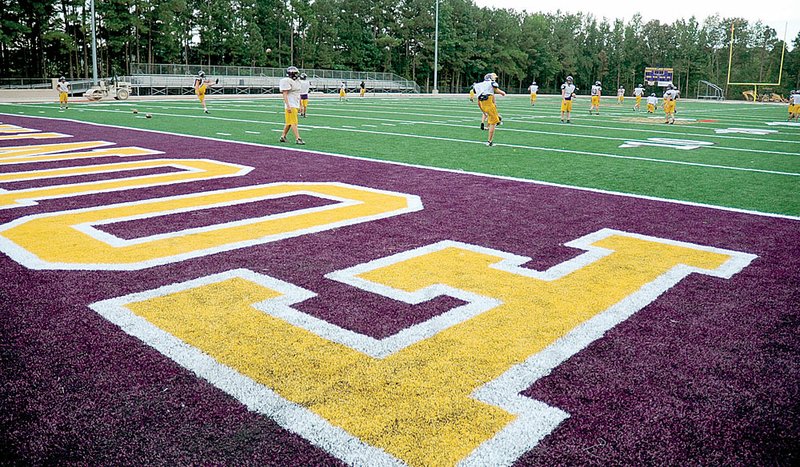FOUNTAIN LAKE — More and more Arkansas high schools are going green, but it’s never looked this lush.
Eleven schools have switched from natural grass to an artificial playing surface this fall, including defending Class 3A state champion Fountain Lake, which will dedicate its new field tonight against Hot Springs Lakeside.
Just 10 years ago, no on campus sites had artificial playing surfaces.
Now, 37 out of the state’s 209-football playing schools this fall, or 17.7 percent, are playing home games on turf.
“I think that number is only going to get bigger,” Fountain Lake Athletic Director Marc Davis said. “I’m sold on it. It’s become one of those deals, where it’s maybe not a necessity, but it’s definitely close.”
Arkansas is not alone in the switch to artificial turf.
According to the synthetic turf council, which released results of a 2009 study earlier this year, there were about 5,500 synthetic turf sports fields in use in the United States in 2009, with nearly 1,000 synthetic turf fields installed at North American schools, colleges, parks and professional sports stadiums. In 2003, 400 fields were installed.
In Arkansas, momentum for switching to artificial surfaces coincided with natural grass playing fields throughout the state being chewed up last fall because of heavy rain and heavy traffic.
Along with Fountain Lake,Bryant, El Dorado, Hot Springs, Lake Hamilton, Little Rock Christian, Pine Bluff, Mena, Russellville and White Hall have gone artificial.
Fountain Lake Coach Tommy Gilleran said conditions became so poor at Beckham Memorial Stadium that his team practiced on the edges of the field to protect the middle of its game field.
“Now we can practice anywhere we want and not worry about life expectancy,” he said.
That’s because Fountain Lake, just north of Hot Springs, spent about $586,000 with Environmental Turf Services, Inc. to install artificial turf this summer, Davis said.
Lake Hamilton, Little Rock Central and Little Rock Christian are other schools that have contracted with Environmental Turf Services, which is headquartered in Madison, Miss.
Fountain Lake’s project was more extensive since the school is also putting in a six-lane track around the field and high jump, long jump and pole vault pits at the south end of the stadium.
Cosmetic work to Beckham Memorial Stadium, affectionately known as “Half-Mile High Stadium,” includes fencing- black wrought iron intertwined with beige brick - lining the field from about the 20 on the northeast side to the 20 on the northwest side.
Fountain Lake’s players will now run onto the field through a new archway, patterned after First Security Stadium at Harding University.
Davis said Beckham Memorial Stadium, carved out of heavily wooded,hilly terrain above Highway 7, is now a picture-perfect fall setting.
“To me, it’s a venue,” Davis said. “It’s become a place that was just a field inside a stadium to a place where people can be proud of now. It’s not only a football field, it’s not only a band field, it’s not only a high school track, it’s a walking place. It’s a place people can be proud of in our community.”
Davis, Fountain Lake’s football coach in 1994-2002, said the school broke ground on the project in late May.
Asked when the school decided to switch from natural grass to artificial turf, Davis said, “late May.”
Armed with a hot product - Fountain Lake finished runner-up in Class 3A before winning its first state championship last fall - Davis was able to raise about $300,000 privately.
The district covered the remaining cost of installing turf, he said.
The cost to switch from natural grass to artificial turf, including excavation, grading work and the product itself, is normally $500,000 to $600,000.
Pulaski Academy in Little Rock raised approximately $550,000 privately to install an artificial playing surface at Rector Field in 2004.
Kevin Kelley, the school’s football coach and athletic director, said he’s ecstatic over the performance of Pro-Green, which was also installed the same year on game fields at Shiloh Christian in Springdale, Rogers and Batesville.
“I love our turf more than anybody else’s I’ve seen,” said Kelley, who led the Class 4A Bruins to state championships in 2003 and 2008. “I like everything about it. Unfortunately, it takes a fall like last fall, when it’sjust so wet, for people to look at it and go, ‘OK, this is going to be the best thing.’ ”
Kelley said he’s hopeful that Pulaski Academy’s surface can last 10 more years before it has to be replaced.
The standard warranty in the industry is about eight years.
Kelley estimated Pulaski Academy was spending between $50,000 and $75,000 annually to maintain its grass field.
In an era where athletic expenditures are under the microscope, schools today have been able to shave costs for turf projects through in-kind donations, aggressive fundraising and tapping into corporate sponsorship.
A Hot Springs automobile dealer, Allen Tillery, paid $150,000 for naming rights to Beckham Memorial Stadium.
In July 2009, Verizon Wireless paid $250,000 for naming rights to Quigley-Cox Stadium, Central’s home.
Summit Bank in Hot Springs paid $150,000 for naming rights to Lake Hamilton’s Wolf Stadium.
Central and Lake Hamilton’s turf projects were funded entirely privately.
All three schools also sold advertising or legacy panels on the field.
Davis said Fountain Lake has 10 advertising panels, ranging in cost from $10,000 to $30,000 each.
“I think you’re going to see more and more schools do this,” Davis said Monday afternoon. “I know I can’t wait for Friday night. When the lights come on, with those purple end zones and goal posts being fluorescent gold, I get goose bumps just thinking about it.”
Sports, Pages 21 on 09/17/2010
